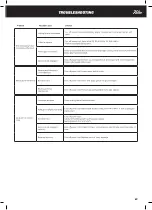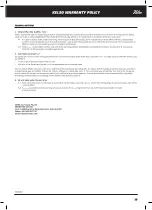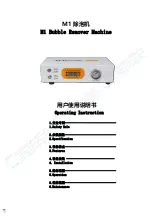
14
SERVICE AND MAINTENANCE
1) Tip the bowl into the downward position. Remove the shaft
endcap and carefully release the split pin.
2) Drop the bowl out of the bearing assembly with the shaft still
attached.
3) Re-position packing washers. To increase gear engagement
reduce the amount of washers at the top of the shaft and move
to the end of the shaft under the split pin.
4) Insert the shaft of the bowl back into the bearing arm
assembly.
5) Insert more packing washers onto the shaft as required. There
should be no vertical movement or gap between the packing
washers and split pin.
6) Insert split pin and using pliers bend split pin ends to secure.
HOW TO APPLY GREASE TO THE TIPPING ARM
CAUTION!
Do not mix grease types. Chemical incompatibility
in lubricants can destroy bearings very quickly. It is advised to
remove all old grease on the first service change to avoid risk.
NOTE:
The grease nipple is a combination ball valve and check
valve. The grease gun depresses the ball valve allowing grease
to pass. When the gun is removed the valve should close, sealing
in the grease. If the valve doesn’t close and grease leaks out,
there may be particulate matter obstructing its proper operation.
You should replace the nipple.
• Always clean off the grease nipple with a rag before
attaching the grease gun coupler. This will prevent pumping
contamination into the bearing assembly.
(Figure 15 - A)
• During first service, remove the top mount plate and clean
away all old grease.
(Figure 15 - B)
• After cleaning, reattach the top mount plate and pump in new
grease with a grease gun.
• Periodically tip the drum using the tipping handles to help
disperse the grease around the shaft.
• Pump enough grease that you hear escaping pressure and
see just a little bit of grease movement squeeze out of the
assembly.
• DO NOT apply grease to the pinion gear or teeth ring. Grease
can attract foreign contaminants leading to premature wear.
CLEANING THE POWER TOOL
CAUTION!
Do not point the water directly at any electrical
components.
• Clean the machine during and after every use. Remove any
dust, residual mixing material and any other dirt.
• Cleaning is best done with a stiff brush. Wear safety glasses
whilst brushing away dust and dirt.
• Use running water from a hose or a high-pressure washer to
clean the product.
• After every mix it is advisable to clear any build-up of cement
from the mixing paddles inside the mixing bowl. If left to
dry the cement can be extremely difficult to remove without
damage to the bowl.
TIP:
Run the Power Tool with a mixture of screenings and
water to remove any dried or clogged cement from inside the
mixing bowl.
• After every mix it is advisable to clear any build-up of cement
from the gears. If left to dry the cement can lead to premature
wear.
• After the last mix wash and clean ALL cement build up from
both inside and outside the mixing bowl and any other exposed
parts before the cement fully sets.
• Avoid hitting the bowl with any objects.
• After cleaning the mixing bowl, the power tool should be stored
with the mixing bowl in the downwards position to ensure all
water is drained.
• Remove grease and oil from the handle.
• The ventilation holes on the motor cover must not be blocked.
• NEVER use solvent-based cleaning agents, these may damage
the painted surfaces or the plastic parts. If you must use these
cleaning agents, test the effect of these agents on a small,
concealed area
FIGURE 15
H
E
A
V
Y
D
U
T
Y
G
R
E
A
S
E
A
B
Summary of Contents for KCM65
Page 2: ......






































